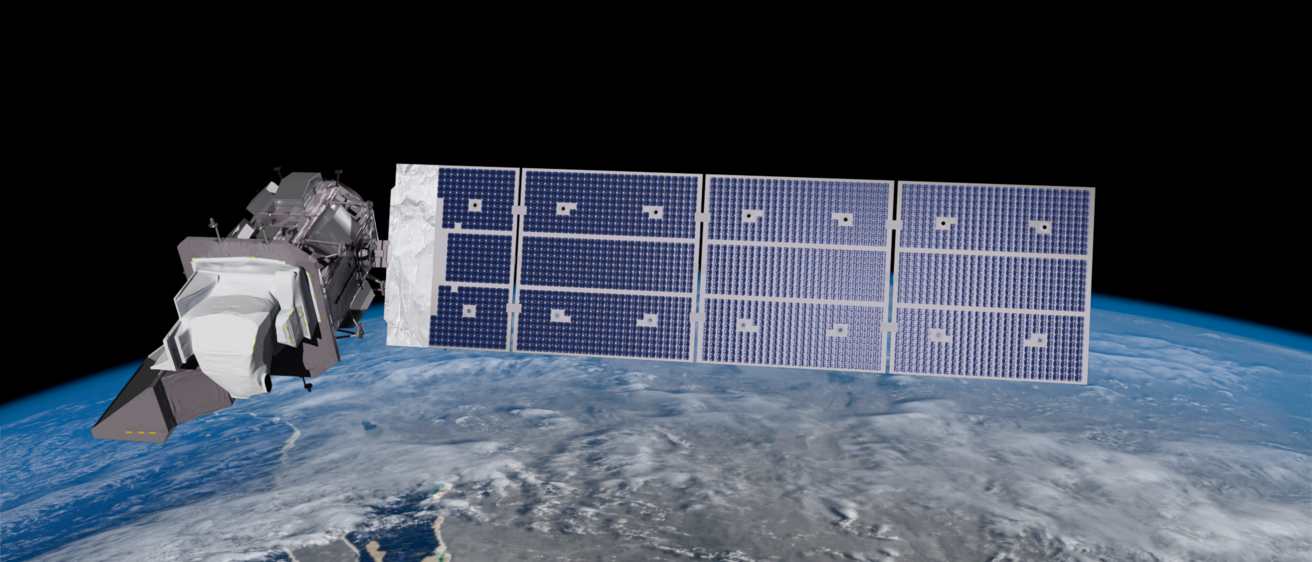
We often associate studying stars, distant planets, and galaxies with satellites, but when a satellite points its telescope down towards Earth, we gain valuable information on our ever-changing surfaces and natural resources. In conjunction with NASA, the United States Geological Survey (USGS) uses Landsat Earth observation satellites to provide data to policymakers and land managers to make informed decisions about the environment. University of Iowa Astronomy MS alumnus, Jacob Richardson, works to improve these satellites at the USGS Sioux Falls location.
Richardson works as a hyperspectral remote sensing scientist which he simply translates to an “expert programmer.” This role allows Richardson to continue working with satellites as he did during his graduate experience, but he has a new perspective of what data is being collected. Richardson works with image spectrometers that continuously take photos of the Earth. Each individual pixel of the image is a spectrum that is being measured and Richardson is tasked with determining when the images taken should be at a higher or lower resolution.
“The mission of my team is to analyze current hyperspectral, or image spectroscopy, missions to figure out how we should deal with all of that data,” Richardson says. “The issue we are tackling is defining the limitations Landsat satellites need—when it should be running, how big each pixel should be, and how we can store that information.”
Most recently Richardson programmed a tool that can identify coincident observations between different satellites, coincident meaning the satellites are at the same place at the same time. Richardson can input broad ranges of time and areas and the tool can detect if there will be 1000 coincident observations inside that range in a few short moments. Identifying these coincident observations aids in making calibrations, determining where detectors should be pointing towards, and lining up their instruments.
Programming has been a passion for Richardson since his time as a physics and astronomy undergraduate student at University of Wisconsin Eau Claire. He describes programming as “a puzzle for him to solve,” and wants to decode scientific problems with programming solutions. After discovering his preferred programming language of Python, Richardson knew he wanted to incorporate this interest into his graduate experience and future career.
“We need more programmers in science fields because programming is almost like the de facto requirement for anything in the realm of science nowadays,” Richardson says. “Computers are better at automated tasks, but it helps alleviate any mistakes when the programmer behind the screen knows the equations and science behind what is happening. I was fortunate that my advisor, Philip Kaaret, was in the final stages of a project called HaloSat where I was able to learn more about spectroscopy all the while improving my Python skills.”

HaloSat is the first cube satellite funded by NASA’s Astrophysics Division that launched from the International Space Station to study x-ray emissions from diffuse gas in the Milky Way galaxy. Philip Kaaret, professor and department chair of the Physics and Astronomy department, states that the x-ray detectors were built at the university and then integrated with a satellite built by industry. The satellite continuously orbited the Earth every 90 minutes for two and a half years, allowing Kaaret, Richardson, and the HaloSat team to observe astronomical targets.
Richardson used his knowledge in astronomy and skills in programming while working on the HaloSat project with Kaaret. He scheduled which targets to observe and programmed files with lists of the targets and commands the space craft needed in order to point in the right direction and turn on its instruments. HaloSat used the supernova remnant known as the Cygnus Loop as a focal point to test its instruments’ calibration. HaloSat observed that target several times during its two-year mission and Richardson analyzed the satellite’s instruments and checked on any degradation of the detectors.
While Richardson did not continue to work in the astronomy field after graduating in May of 2021, his master’s of science degree in Astronomy improved his data analysis, critical thinking, and problem-solving skills that easily translated to his current position of Earth observation. Kaaret jokes that he tried to convince Richardson to pursue a PhD in Astronomy but acknowledges that Richardson wasn’t tied down to an academic career in science.
“He came in with a clear notion that a master’s degree would provide enough training for his career path, and he was absolutely right,” Kaaret concludes.
Richardson took an unusual path to the USGS by pursuing astronomy as many of his current colleagues studied geology, geography, and biology. He admits that working at the USGS did not cross his mind until the position opened up because he always assumed he would work at NASA or other space agencies. While the HaloSat project and astronomy classes prepared Richardson for a job looking up at the stars, it led him to a career looking back down to the Earth from space.
“Little did I know that programming and working with a spectrometer for my time with HaloSat would be incredibly useful for my career at the USGS where I program and work with spectrometers daily,” Richardson says. “The only major difference between what I’m doing at the USGS and what I did in my graduate courses is changing which way the telescope is pointing!”
By Madison Long, graduate research assistant, writer/editor, UI Graduate College
